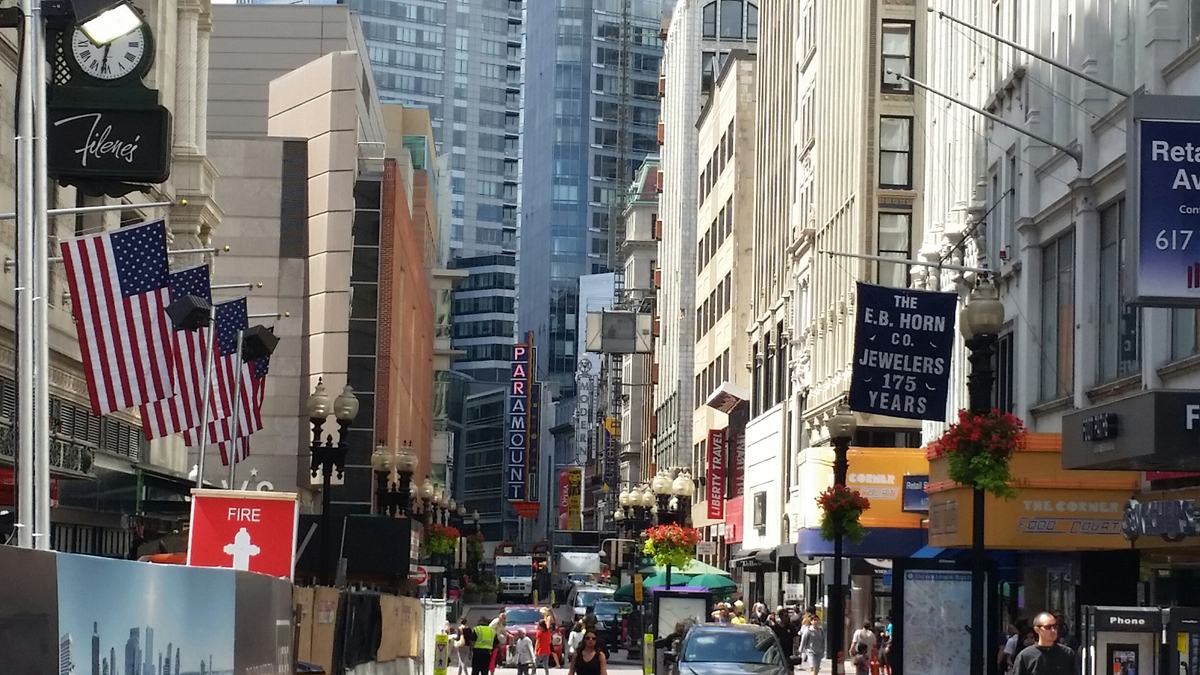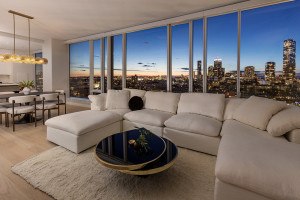Downtown Crossing Is Improving, According to Area Business Leaders

Photo by John A. Keith
The 575 guests who attended Bisnow‘s Future of Downtown Boston Summit last week heard mostly positive things about Downtown Crossing from the event’s featured speakers. That’s an improvement for the neighborhood, which has suffered greatly during the past 60 years, ever since visitors to Boston abandoned our city’s primary shopping district for the malls of the suburbs.
Larry DiCara, a historian and former City Councilor, kicked things off with his typical flair for the unexpected, calling for the relocation of City Hall to Winthrop Square and the end of buses on the streets of downtown Boston. Then Paul McMorrow, of Commonwealth Magazine, moderated a keynote interview with Tony Pangaro and Ron Druker. His first question was regarding the state of Downtown Crossing as it is now, and what the biggest challenge is to keeping it on the right track toward greater success.
To Anthony Pangaro of Millennium Partners, the company behind the Ritz-Carlton Towers and Millennium Place condominium developments and the under-construction Burnham Building / Millennium Tower project, the biggest threat to the neighborhood’s growth is the lack of a focus on transportation. “Downtown Crossing has five transit lines, very good local bus service, as well as two commuter rail stations,” said Pangaro, who spent seven years putting together the MBTA’s Southwest Corridor project in the 1970s. “Infrastructure is crucial. I think the crossroads that we’re at—we’ve got to reinvest or we’re going to lose the thing that keeps us alive. We’ve got a greater density, people without cars, but at some point our transit system is the lifeblood. If we let it go, what we’re doing today won’t work for very much longer.”
Ronald Druker, of the Druker Company, agreed. As he told the crowd, the three most important things in real estate are “transportation, transportation, and transportation.” To him, Downtown Crossing has something that no other neighborhood in Boston can replicate: it’s the nexus of where people must go through; the result of that is the differentiating factor between Downtown Crossing and the Seaport District. “In the Downtown Crossing, there is a fabric, a feeling that you’re in the city,” said Druker. “Old, new, a difference in demographics, the feel of a city. The Seaport is never going to feel like the heart of the city.”
The second half of the summit was moderated by Allen Lynch, a partner at Nixon Peabody. Panelists Rosemarie Sansone of the Downtown Boston Business Improvement District and Margaret Ann Ings of Emerson College sang the praises of Downtown Crossing; they didn’t dwell on the problems that still exist the neighborhood—the things that are noticeable to anyone spending any amount of time there. The row of empty storefronts, the people who hang around all day, how it’s deserted after 6 at night. Little was said about the negative effects Downtown Crossing’s resurgence is having on the residents of Chinatown, just down the street.
That was until third panelist Kirk Sykes of the New Boston Fund spoke up. How will people afford to live here given the current environment and the cost of construction?, he asked.
Sykes has a great perspective on that challenge. The New Boston Fund is co-developing One Greenway in Chinatown, a residential project that will bring 362 units of housing to the neighborhood, 40 percent of which will be affordable or income-restricted.
“Whether you think it’s socially right or socially wrong, whether it should be equitable for residents of Chinatown to be able to stay in Chinatown or not, I think from a business perspective it’s really important,” he said. “People want original; they don’t want sanitized. What’s cool about downtown is everyone is here. A real diversity of folks. How do we facilitate that?”
Speaking from the audience, Ron Druker answered that question. Not all of the housing being built in Downtown Crossing is “luxury,” but it is expensive, and that’s because of what it costs to build: above $4.5 per foot, closer to $5 per foot for steel high-rises. It’s expensive to build there, so it’s expensive to buy and rent there, he said.
Unfortunately, Druker’s response came just as time was up and the summit was over, so no one in the audience had a chance for follow-up. The possible solutions to the neighborhood’s housing problem will have to be a discussion for another day.


